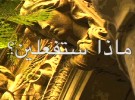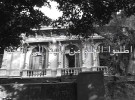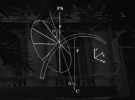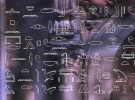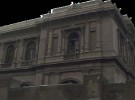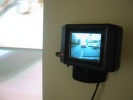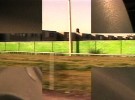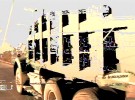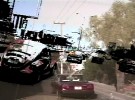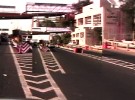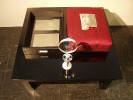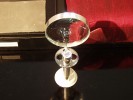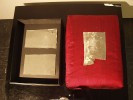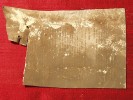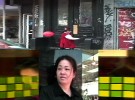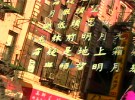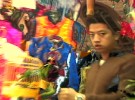Palace of Contemplation, 5 Sunsets and 5 Dawns, a 20 minute DVD video art work presented at the Cairo Opera House Art Gallery, Cairo, Egypt, uses the concept of the book to explore notions of learning, and uses the image of a book to create a “frame story†which “bookends†the piece. It is a poetic evocation of the Abandoned Halim Palace in Cairo, as well as a meditation on the whole life cycle of the building and its meaning in people’s lives, both throughout its current history, and into envisioned possible futures.
Video Stills:
Video Excerpt:
(Note: The first 49 seconds of the piece are completely silent. Best watched in High Quality – Click video once to play, then after video begins click the “HQ” icon on the lower right. Video will restart in High Quality.)
[tubepress]
Project Description:
In 2005, with the help of friends, I came across an abandoned palace which sits right in the heart of Cairo, in the Ismailia district, a poor neighborhood of auto chop shops and car mechanics.
It was built by Prince Saiid Halim Pasha, a grandson of Mohammed Ali (Wali of Egypt for the Ottoman Empire, and regarded as the “founder of modern Egypt”). Saiid Halim who became the Grand Vizier of the Ottoman Empire, built the grand red marble town house for his wife Amina Indji Toussoun, herself a great-granddaughter of Mohammed Ali. History has it that Prince Halim’s father could have been the ruler of all Egypt had it not been for his highly ambitious nephew.
On the first day of Ramadan I was able to arrange a tour of the place. I was taken both by the architecture and by its history, it having been a school first for elites, and in the end for wayward youth, before becoming totally abandoned. Some people had the idea of turning it into a contemporary art museum, but the neighborhood it resides in was beginning to show the signs of gentrification, and others wished to see it torn down or converted to luxury living space.
Several days later I came back with a video camera to document the building with an eye toward creating an artwork, but by this time the mood had already changed. Arriving at the front gates, I was met by guards who informed me that for safety’s sake, no one was allowed to enter. The artwork about this piece of architecture had already begun forming in my mind. Denied access, I decided simply to walk the perimeter and record a single circumambulation of the space.
The work uses the concept of the book to explore notions of learning, and uses the image of a book to create a “frame story” which “bookends” the piece. The video begins with the image of a grammar school book from the actual site, and tells the brief story of a boy from the school and the powerful Egyptian ruler who built the palace for his wife. Text about the boy comes not from the book pictured, but rather from an open source wiki book intended to teach Arabic to English speakers, and this same text appears later in the video in Arabic as well.
A little like the 1939 feature film “The Wizard of Oz” in which the “dream sequence” (in color) is the most vivid part, in “Palace…” sound and active movement only occur during the circumambulation stage, representing an imaginary five year journey into the future.
The Buraq was a kind of mythical winged horse and the traditional lightning steed of the prophets for dream journeys. Here in this neighborhood of garages and auto mechanics, the Buraq is replaced by the sound of a mini van starting up at the beginning of the journey, then driving away at the end.
Egypt is primarily Sunni, among whom fasting during Ramadan is considered one of the Five Pillars of Islam: fasting, charity, prayer five times a day, proclamation of faith, and making a pilgrimage to Mecca. “Palace…” involves a kind of pilgrimage around the space, and as Ramadan begins at dawn and ends with sunset, (thus completing the holy month until the following year,) the phrase “Five Sunsets and Five Dawns” actually indicates a passage of five years.
The number five appears in the work in a number of other ways as well, including a hand drawn chart showing the four seasons plus the month of Ramadan, the screen split into quadrants with a full screen layer above, and the overlay in the video of five kinds of language – namely Arabic, English, ancient Egyptian, the language of mathematics, and of symbols drawn by children.
As the journey circling the building begins, the viewer is asked to imagine what the Halim Palace might be, five Ramadans into the future. Montaged over the video documenting the exterior are the drawings charting Ramadan to 2010 as it clocks around the seasons, tracings of actual children’s drawings left behind at the site from the days of the school, mathematical symbols relating to light and learning, as well as parts of an ancient Egyptian tale in hieroglyphics, used to educate scribes. Elements of text in the video are in both English and Arabic, and include common Arabic proverbs relating to the palace, such as “Seek education from the cradle to the grave.”
The sound track is composed of audio from popular radio stations recorded in cabs in downtown Cairo, ambient street noise from the circling walk, and traditional Zar music, an ancient Egyptian ritual healing music, recorded live in a studio on the outskirts of the city.
The piece is a poetic evocation of my personal experience of the physical space, as well as a meditation on the whole life cycle of the building and its meaning in peoples lives, both throughout its current history, and into envisioned possible futures.
A one hour long, two channel, three screen, dvd video installation. Created through a live video mix performance, it deals with street level architecture, globalization, and the meaning of work, home, and place, and was presented in the group show Une promesse de malheur, curated by Edgar Orlaineta, at GAM – GalerÃa de Arte Mexicano.
Video stills and photo documentation of the installation:
Â
Video Excerpt [4min, 53sec]:
Note: Best watched in High Quality – Click video once to play, then after video begins click the “HQ” icon on the lower right. Video will restart in High Quality.
[tubepress mode=’playlist’, playlistValue=’2802BFB8249A419F’]
Project Description:
The first part of the title refers to two cities, New York (NY) and Ciudad de México, Distrito Federal (DF), and the second part translates in English as “going to work, going home.” The piece is created from footage shot in both cities, recorded by the artist and a range of people who work at the GalerÃa de Arte Mexicano, focusing solely on traveling to work and traveling home. The video footage is mixed with satellite photography, maps, and various forms of business and other data, suggesting the socioeconomic as well as geographic connections between the two cities.
As Mexico City grows, working people move further and further into the expanding periphery and one can see the infrastructure of highways and services struggling to keep pace. This same overflow leads some to travel North and there has been a huge new influx of laborers into the New York City area, helping power that city’s economy from the ground up. The energy of this expansion is echoed in the hard driving and rapidly changing “music video style” imagery used in the artwork.
NYDF Concentrates on the activity of going to work and going home, cars honking, drivers cursing, changing radio stations, traffic jams, and an almost comedic sense of being overwhelmed by the journey. Yet despite the “club visuals” style, the piece ends with arriving home and the simple pleasures of children and family. That is, until the epilogue, in which the whole thing starts all over again.
Advertising, shopping, architectural development, corporate media – these are complex cultural processes that are colonizing and overtaking public space. A kind of Global and urban sprawl is creating a hither-to-unimagined world that we now must function in on a daily basis. This encroachment endangers the creative environment needed by every individual. The urban street-scape is being converted more and more to a site of corporate bombardment and endless counterproductive transport, rather than community interaction.
NYDF represents an attempt to look at what we have made around us, to wake up to our own participation, and, at the same time, to honor the beauty and immediacy of individual lived experience in the present moment.
Contributors to the project: Lourdes MarroquÃn Hernández Edgar Orlaineta Mariana Pérez Amor Faustino Serna Nuñez.
The Triumph of Romanticism
A sculptural meditation on the physical nature of books and printing in the contemporary electronic era, composed of fragments of printing plates, document box, pillow, table, flashlight, magnifying glass, and statement. The project description or statement, a part of the artwork itself, is intended to be displayed along with the other elements. It comments both on romanticism generally, and specifically on the very notion of “text” and the idea of “books” in our current digital era. It contains within it a story of the artist in his garret, creating the work as he “begins feverishly to cut the pages one by one…”
24″x36″x36″ at Maxwell Fine Art, Peekskill, New York
Â
Project Description:
“The Triumph of Romanticism” consists of an archival quality lined leather bound document box, a rectangular Indian red silk display pillow of exactly the same dimensions as the box, a chrome and ceramic stand holding a silver flashlight and magnifying glass, a low square traditional oriental table on which all the elements reside, and 58 fragments of hydrophilic offset lithography plates originally used in the printing of an old literary survey book containing a chapter entitled “Triumph of Romanticism.”
The plates were discovered during demo of a 2000 square foot loft in Williamsburg Brooklyn that was being rehabbed. The plates had been used as a building material, forming the ceiling area around a large skylight.
The story seems hardly plausible, but it is entirely true. Picture if you will, the artist in his garret. There is no heat, not even a radiator. There is no electricity. Water is pouring in from around the edges of the skylight above. A shaft of cold winter light bathes the room. In a desperate attempt to discover the source and staunch the flood, and working from instinct rather than reason, the artist begins ripping away the ceiling around the skylight.
Suddenly a discovery is made, on the reverse side of the dingy white metal ceiling flashing is the text of a work. The very ceiling itself – is a book! In his ecstatic and frenzied state, the Sturm und Drang of the artists dreary existence is forgotten. Seizing a pair of tin snips, and drenched in the icy water pouring down around him, the artist begins feverishly to cut the pages one by one from the ceiling.
For the printed work, offset lithography long ago replaced typesetting as the favored method for making books. Today this method itself is being replaced by print-on-demand from ink jet printers, reading on line, and ebooks. Unlike letterpress, offset printing does not involve raised or etched surfaces. Rather, metal plates are chemically treated to retain water in areas that are to be blank space, and reject water but attract grease or oily ink in areas of text. The plates pass the ink to a rubber surface where it is temporarily offset in reverse, and then to the paper. The result not only involves very little wear and thus allows for large print runs, but it also coincidentally means that the shiny text on the surface of the plates is not reversed and thus perfectly legible, just as regular pages in a book.
“The Triumph of Romanticism” evokes both the 19th century love of archiving, and the impression of a lost antiquity displayed in a cabinet of curiosities. The book preserved as ancient or exotic artifact.
This depiction is reenforced by the changes in society relating to text. It is not uncommon for people these days to consider digital text (where the computer understands each character as individually editable) as “actual” text and printed pages as a kind of archaic picture or snapshot, and not the thing itself. The printed page as dumb object, both annoying and of little use. A kind of ghost or residue of the actual text.
Yet this stupid physical object text may soon be all we have left to preserve text with. A host of systems for Digital Rights Management or DRM are being trotted out by corporations attempting to put a strangle hold on the free flow of information caused by the invention of the internet. The argument they make is they are simply trying to protect the copyright so that people can receive just compensation, but the threat to our freedom to read, teach, and preserve books is so great that the American Library Association, in its Office for Information Technology Policy Brief “Digital Rights Management: A Guide for Librarians” outlines at least six key areas of concern where DRM could fundamentally harm the preservation of cultural knowledge for the future. This is because it involves encoding the digital information in such a way that even though you may be in possession of the digital book,the DRM controller decides what and how you can and can not read.
Yet writing is by nature an encoding, and thus always requires some device to decode it – whether a computer program, or simply vision, speech, and language. Cory Doctorow in his brilliant and impressive critique of DRM from the June 17, 2004, “Microsoft Research DRM talk” says “Paper books are the packaging that books come in.” Though he makes light of “how nice a book looks on your bookcase and how nice it smells” and seems almost dismissive of paper books as trash, this statement regarding books and packaging contains a vital notion. The book is the ideas encoded in the text, no matter what form the text is delivered in.
And so we finally circle back around to the book in the ceiling and the artwork made from it. In the electronic text age, here is the supposed “Triumph of Romanticism” – some loose fragments of metal left over from the dark ages of printing. Clearly there is no triumph. This does not constitute the effective preservation of 19th century literature, nor does it solve the problem of how to preserve books, in general, in the face of the overwhelming corporate and national control of media in the coming generation of the electronic age.
In the “The Triumph of Romanticism” the two forgotten art forms of books and found art come together in some kind of pale continued existence. The display, stuck in a maudlin reverence and elegiac longing for the past, strives mightily to achieve its goal, and fails. Yet what is this but a kind of reencoding and presentation of a lost set of ideals – the very essence of romanticism?
Gai Tong Ap Guong [Chicken with Duck Talks], a one hour long DVD video artwork, presented as a street level art installation in conjunction with Red Dive’s project entitled Peripheral City: City of Refuge.
“The mere smell of cooking can evoke a whole civilization” – Fernand Brandel
“Do not dismiss the dish by saying that it is just simple food. The blessed thing is an entire civilization in itself” – Abdulhak Sinasi
“Sweet, sour, bitter, pungent – all must be tasted” – Chinese Proverb
Video Documentation:
[tubepress video=”73Zh-Gu7Fus”]
Project Description:
Chinatown New York City, the largest Chinatown in the United States, is currently expanding do to a variety of economic and political forces in the city and on the far side of the globe – but how will the gentrification of the whole Lower East Side effect this bastion of history and culture? Since 1878 when the first Chinese grocery store, Wo Kee, opened on Mott Street, and in the same year the U.S. Supreme Court denied Chinese the right to become American citizens, the people of Chinatown have had the dual struggle to both survive on a daily basis and at the same time preserve their rights and culture. In the present moment The Asian American Arts Centre is battling eviction by landlords bent on gentrification. What changes are happening in the neighborhood and how can its value be preserved? What are the simple every day familiarities and pleasures that define culture on a daily basis?
Gai Tong Ap Guong  makes use of audio, video, photography, and puppetry. It combines documentary photographs, traveling imagery of the street level built environment and interviews with the people who live in the neighborhood. Audio and text on screen is in both Chinese and English.
The title refers to a common saying in Cantonese about culture clash. It translates something like “(When) Chicken with Duck Talks (Neither Understands.)” A typical fixture in many restaurants in Chinatown, skinned ducks and chickens, often with the heads and necks still attached, hang in front windows as an appetizing enticement.
Gai Tong Ap Guong uses the traditional saying as a means to pose questions to the local inhabitants about their own neighborhood and cultural change which has occurred or is currently going on around them, and attempts to capture the almost hallucinogenic density of daily experience in Chinatown.
Corky Lee (Additional Black and White Photography)Â
Teri Chan (Interviews)Â
Raul Rothblatt, Eric Jiaju Lee (Musicians)
Special thanks to Maureen, and everyone at Red Dive, and to Mr. Choy, Mark, Mike, and everyone at Silkroad.







